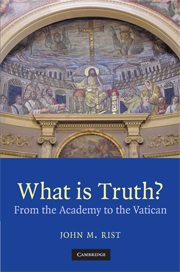Book contents
- Frontmatter
- Contents
- Acknowledgments
- Abbreviations
- Introduction: Partial and universal truth
- 1 The human race, or how could women be created in the image and likeness of God?
- 2 Divine justice and man's “genetic” flaw
- 3 Divine beauty: Nature, art and humanity
- 4 The origin and early development of episcopacy at Rome
- 5 Caesaropapism, theocracy or neo-Augustinian politics?
- 6 The Catholic Church in “modern” and “post-modern” culture
- 7 Looking at hopes and fears in the rear mirror
- Bibliography
- Index
7 - Looking at hopes and fears in the rear mirror
Published online by Cambridge University Press: 05 June 2012
- Frontmatter
- Contents
- Acknowledgments
- Abbreviations
- Introduction: Partial and universal truth
- 1 The human race, or how could women be created in the image and likeness of God?
- 2 Divine justice and man's “genetic” flaw
- 3 Divine beauty: Nature, art and humanity
- 4 The origin and early development of episcopacy at Rome
- 5 Caesaropapism, theocracy or neo-Augustinian politics?
- 6 The Catholic Church in “modern” and “post-modern” culture
- 7 Looking at hopes and fears in the rear mirror
- Bibliography
- Index
Summary
We need a Caliph who would chop hands, cut throats, stone people in the same way that the messenger of God used to chop hands, cut throats and stone people.
Ayatollah KhomeiniCURRENT THREATS AND FUNDAMENTALIST RESPONSES
I have argued in the preceding chapters that, just as we can identify development in Christian doctrine, so we can see a development in our understanding of the role of the Church and – a particularly illuminating example – of the see of Rome, as well as the ever-widening possibilities of the socio-political, moral and aesthetic aspects of Christian culture. Instead of shrinking within some fundamentalist core of “saving truth” we need to further the growth of all the implications of that saving truth: that is, of all that is compatible with it. Newman's identification of the development of Christian doctrine concerned itself with distinguishing between legitimate growth and the growth of abuses within the strictly religious – that is, salvational – sphere; and within those limits it has been of immense value, despite some weaknesses, notably the privileging of the state of doctrine in the fourth and fifth centuries to the extent of reading such ideas back into the first three centuries of the Christian era. Newman's theory was worked out largely in the context of a defence of the Church of Rome against Protestantism, viewed as pervaded by the spirit of individualism, of a “pick-and-mix” Christianity.
- Type
- Chapter
- Information
- What is Truth?From the Academy to the Vatican, pp. 319 - 341Publisher: Cambridge University PressPrint publication year: 2008

